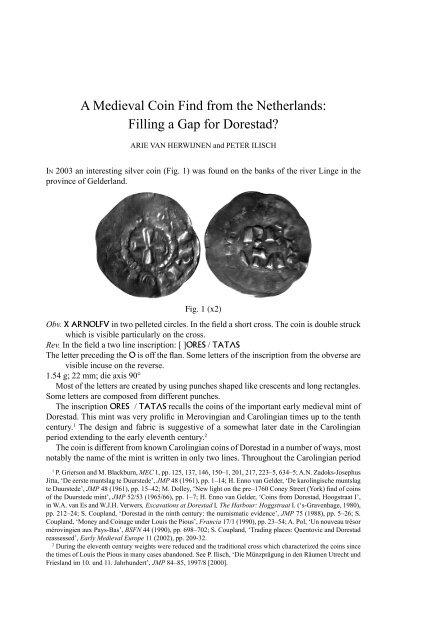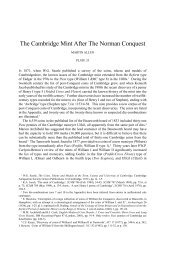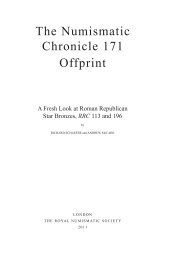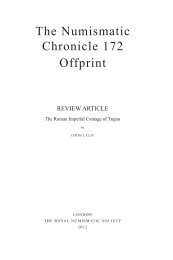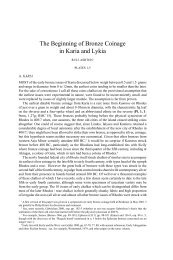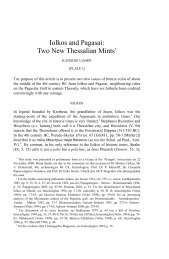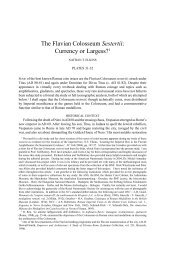A Medieval Coin Find from the Netherlands - Royal Numismatic ...
A Medieval Coin Find from the Netherlands - Royal Numismatic ...
A Medieval Coin Find from the Netherlands - Royal Numismatic ...
You also want an ePaper? Increase the reach of your titles
YUMPU automatically turns print PDFs into web optimized ePapers that Google loves.
A MEDIEVAL COIN FIND FROM THE NETHERLANDS 245<br />
A <strong>Medieval</strong> <strong>Coin</strong> <strong>Find</strong> <strong>from</strong> <strong>the</strong> Ne<strong>the</strong>rlands:<br />
Filling a Gap for Dorestad?<br />
ARIE VAN HERWIJNEN and PETER ILISCH<br />
IN 2003 an interesting silver coin (Fig. 1) was found on <strong>the</strong> banks of <strong>the</strong> river Linge in <strong>the</strong><br />
province of Gelderland.<br />
Fig. 1 (x2)<br />
Obv. X ARNOLFV in two pelleted circles. In <strong>the</strong> fi eld a short cross. The coin is double struck<br />
which is visible particularly on <strong>the</strong> cross.<br />
Rev. In <strong>the</strong> fi eld a two line inscription: [ ]ORES / TATãS<br />
The letter preceding <strong>the</strong> O is off <strong>the</strong> fl an. Some letters of <strong>the</strong> inscription <strong>from</strong> <strong>the</strong> obverse are<br />
visible incuse on <strong>the</strong> reverse.<br />
1.54 g; 22 mm; die axis 90°<br />
Most of <strong>the</strong> letters are created by using punches shaped like crescents and long rectangles.<br />
Some letters are composed <strong>from</strong> different punches.<br />
The inscription ORES / TATãS recalls <strong>the</strong> coins of <strong>the</strong> important early medieval mint of<br />
Dorestad. This mint was very prolifi c in Merovingian and Carolingian times up to <strong>the</strong> tenth<br />
century. 1 The design and fabric is suggestive of a somewhat later date in <strong>the</strong> Carolingian<br />
period extending to <strong>the</strong> early eleventh century. 2<br />
The coin is different <strong>from</strong> known Carolingian coins of Dorestad in a number of ways, most<br />
notably <strong>the</strong> name of <strong>the</strong> mint is written in only two lines. Throughout <strong>the</strong> Carolingian period<br />
1 P. Grierson and M. Blackburn, MEC 1, pp. 125, 137, 146, 150–1, 201, 217, 223–5, 634–5; A.N. Zadoks-Josephus<br />
Jitta, ‘De eerste muntslag te Duurstede’, JMP 48 (1961), pp. 1–14; H. Enno van Gelder, ‘De karolingische muntslag<br />
te Duurstede’, JMP 48 (1961), pp. 15–42; M. Dolley, ‘New light on <strong>the</strong> pre–1760 Coney Street (York) fi nd of coins<br />
of <strong>the</strong> Duurstede mint’, JMP 52/53 (1965/66), pp. 1–7; H. Enno van Gelder, ‘<strong>Coin</strong>s <strong>from</strong> Dorestad, Hoogstraat I’,<br />
in W.A. van Es and W.J.H. Verwers, Excavations at Dorestad I, The Harbour: Hoggstraat I. (‘s-Gravenhage, 1980),<br />
pp. 212–24; S. Coupland, ‘Dorestad in <strong>the</strong> ninth century: <strong>the</strong> numismatic evidence’, JMP 75 (1988), pp. 5–26; S.<br />
Coupland, ‘Money and <strong>Coin</strong>age under Louis <strong>the</strong> Pious’, Francia 17/1 (1990), pp. 23–54; A. Pol, ‘Un nouveau trésor<br />
mérovingien aux Pays-Bas’, BSFN 44 (1990), pp. 698–702; S. Coupland, ‘Trading places: Quentovic and Dorestad<br />
reassessed’, Early <strong>Medieval</strong> Europe 11 (2002), pp. 209-32.<br />
2 During <strong>the</strong> eleventh century weights were reduced and <strong>the</strong> traditional cross which characterized <strong>the</strong> coins since<br />
<strong>the</strong> times of Louis <strong>the</strong> Pious in many cases abandoned. See P. Ilisch, ‘Die Münzprägung in den Räumen Utrecht und<br />
Friesland im 10. und 11. Jahrhundert’, JMP 84–85, 1997/8 [2000].
246<br />
ARIE VAN HERWIJNEN and PETER ILISCH<br />
<strong>the</strong> name was usually written in three lines and this was <strong>the</strong> case with <strong>the</strong> last substantive<br />
issue in <strong>the</strong> name of Emperor Lothar. (Fig. 2) These coins have usually been attributed to<br />
Lothar I (817–840/55) but Enno Van Gelder has suggested that <strong>the</strong>y could have been struck<br />
under Lothar II (855–69). This has been contested by Simon Coupland, who dates <strong>the</strong> issue to<br />
<strong>the</strong> early 850s. 3 Ei<strong>the</strong>r way <strong>the</strong> two line version of <strong>the</strong> mint name on <strong>the</strong> present coin strongly<br />
suggests that it is not just a barbarous copy of a late Carolingian issue.<br />
Fig. 2 (x2)<br />
The style of <strong>the</strong> lettering is also different <strong>from</strong> known Dorestad coins. In particular <strong>the</strong><br />
punches have been used to shape <strong>the</strong> letter S in a different way. The same is true of <strong>the</strong> O<br />
and A though <strong>the</strong> E and R are closer in style to <strong>the</strong> usual Dorestad coins. The use of punches<br />
to facilitate <strong>the</strong> production of dies possibly started in Dorestad but soon became a common<br />
practice in many Carolingian mints. 4 These differences could be explained as <strong>the</strong> work of<br />
different mint personnel and hence could indicate a date after 855. The diameter of <strong>the</strong> coin<br />
is 2 mm larger than <strong>the</strong> Dorestad coins with <strong>the</strong> mint’s name in three lines. The weight of <strong>the</strong><br />
coin is roughly about <strong>the</strong> same as <strong>the</strong> known Dorestad types.<br />
In Dorestad <strong>the</strong> dies were made with square heads resulting in a die alignment which could<br />
be one of four ways. 5 This technique was unique to Dorestad where it had been used for <strong>the</strong><br />
temple type of Lothar and <strong>the</strong> preceding coinage of Louis <strong>the</strong> Pious (814–40). 6 On our coin<br />
<strong>the</strong> die axis is 90 degrees which also points to Dorestad as <strong>the</strong> mint. Sometimes coins of <strong>the</strong><br />
last decades of <strong>the</strong> ninth century were struck with over-used dies which again is <strong>the</strong> case with<br />
this coin.<br />
Simon Coupland has argued that minting ceased at Dorestad around 8557 whereas van<br />
Gelder thought that it continued into <strong>the</strong> reign of Lothar II. 8 We can not discuss <strong>the</strong> chronology<br />
of Lothar’s coinage in Dorestad in detail here.<br />
3 K.F. Morrisson and H. Grunthal, Carolingian <strong>Coin</strong>age (ANS NNM 158; New York, 1967), p. 160, no. 521;<br />
van Gelder, ‘Karolingische muntslag’, pp. 33, 36; Coupland, ‘Dorestad in <strong>the</strong> ninth century’, p. 21 (based on <strong>the</strong><br />
occurrence of such coins in three hoards); Coupland, ‘Trading places’, p. 226.<br />
4 Van Gelder, ‘Karolingische muntslag’, pp. 25–6.<br />
5 Van Gelder ‘Karolingische muntslag’, pp. 26–7.<br />
6 It is also to be observed on <strong>the</strong> pieces with blundered legends which were formerly regarded as Frisian imitations.<br />
This interpretation has been strongly rejected by Simon Coupland, ‘The coinage of Lothar I. (840–855)’, NC 161<br />
(2001), pp. 157–99 at pp. 173–4; see also van Gelder ‘Karolingische muntslag’, p. 26; Coupland ‘Trading places’, p.<br />
223; Grierson and Blackburn, MEC nos 819–20; A. Pol, ‘Spectaculaire muntvondst uit de 9de eeuw’, De Beldenaar<br />
16 (1992), pp. 6–71 at p. 68.<br />
7 Coupland ‘Trading places’, p. 226: ‘<strong>the</strong>re are no known Dorestad issues of Lothar II’.<br />
8 Van Gelder ‘Karolingische muntslag’, pp. 27, 36 (‘waarvan de aanmunting in 875 nog in volle gang geweest<br />
moet zijn’), 42. Van Gelder, however, had thought that <strong>the</strong> three line-type with DOR – ESTA – TVS and <strong>the</strong> name of<br />
Lothar was struck in Frisia and not at Dorestad.
A MEDIEVAL COIN FIND FROM THE NETHERLANDS 247<br />
MINTING AUTHORITY AND DATING<br />
The visible legend on <strong>the</strong> reverse of <strong>the</strong> coin is XARNOLFV. There is space on <strong>the</strong> coin<br />
to expand this to XARNOLFVS REX (king) or xARNOLFVS IMP (emperor). These are <strong>the</strong><br />
obvious suggestions but <strong>the</strong> title DVX (duke), COM (count), EPS (bishop) or A-B (abbot)<br />
could <strong>the</strong>oretically fi ll <strong>the</strong> unreadable part of <strong>the</strong> text. It seems sensible to look for rulers<br />
named Arnold or Arnulf and <strong>the</strong>n try to fi nd <strong>the</strong> missing title. As a rule in <strong>the</strong> eleventh century<br />
generally coins <strong>from</strong> far away mints are unlikely to be found in <strong>the</strong> Ne<strong>the</strong>rlands apart <strong>from</strong><br />
by <strong>the</strong> sea.<br />
In chronological order <strong>the</strong> following persons have to be taken in consideration:<br />
1. Arnulf of Carinthia (king 887–95; emperor 896–9). This Arnulf minted in many<br />
different places: Mainz, Toul, Thuin, Regensburg, Milan, Pavia and Rome as well as<br />
some unidentifi ed mints. 9 On his coins his name is spelled in three different ways:<br />
ARNOLDVS, ARNVLFVS and ARNOLFVS. <strong>Coin</strong>s were minted during <strong>the</strong> time he<br />
was king and also during <strong>the</strong> time when he was emperor, so ei<strong>the</strong>r <strong>the</strong> title REX or IMP<br />
can be present on his coins.<br />
2. Arnulf (duke of Bavaria 911–37). <strong>Coin</strong>s, minted in Regensburg, are known with<br />
ARNVLFVS and <strong>the</strong> title DVX. 10 A coin is also known <strong>from</strong> him minted in Salzburg<br />
with <strong>the</strong> same spelling of his name and title. 11<br />
3. Arnulf I count of Flanders (918–65). 12<br />
4. Arnulf II count of Flanders (964–88).<br />
The following can be ruled out on account of <strong>the</strong> fi nd spot and <strong>the</strong> high weight of <strong>the</strong> coin<br />
which would be unlikely after 1000:<br />
1. Arnulf, bishop of Halberstadt (996–1023). <strong>Coin</strong>s known with ARNVLFVS and EPS. 13<br />
2. Arnold I bishop of Worms (1044–65). <strong>Coin</strong>s are known with ARNOLDVS and EPS. 14<br />
3. Arnold I of Falkenberg, abbot of Corvey (1051–5). One coin known with ARNOLD<br />
and A-B. 15<br />
The reading we are looking for (ARNOLFVS), only appears on <strong>the</strong> coins of Arnulf of<br />
Carinthia. Taking into account that <strong>the</strong> coin was most likely struck in <strong>the</strong> second half of<br />
<strong>the</strong> ninth century and bears <strong>the</strong> name of Dorestad, Arnulf of Carinthia seems to be <strong>the</strong> best<br />
candidate. Whe<strong>the</strong>r we must fi ll <strong>the</strong> space with REX or IMP is not clear and this will have to<br />
wait until ano<strong>the</strong>r coin of this type is found.<br />
Arnulf of Carinthia was born around 850. He was a grandson of Louis <strong>the</strong> German<br />
(emperor 840–76) and <strong>the</strong> son of <strong>the</strong> king of Bavaria Karloman (876–80). In 887 he was able<br />
to dethrone <strong>the</strong> seriously ill Charles III (<strong>the</strong> Fat) as ruler of <strong>the</strong> East Frankish Empire. When<br />
Charles died in 888 <strong>the</strong> division of <strong>the</strong> Carolingian Empire was sealed. In Italy, Burgundy,<br />
Lotharingia and Western Francia individual kings seized power. Lombardy was conquered<br />
9 W. Hahn, ‘Die Münzprägung des Königs und Kaisers Arnulf, genannt ‘von Carinthia’ (887–899)’, Money Trend<br />
37 no. 6, (2005), pp. 154–62.<br />
10 H. Dannenberg, Die Deutschen Münzen der Sächsischen und Fränkischen Kaiserzeit (Berlin, 1876) nos<br />
1046–47, 1049–51, 1699; W. Hahn, Monetas Radasponensis. Bayerns Münzprägung im 9., 10. und 11. Jahrhundert<br />
(Brunswick, 1976) p. 78, no.5.<br />
11 Dannenberg, Sächsischen und Fränkischen Kaiserzeit, no. 1127; Hahn, Moneta Radasponensis, p. 93, no. 86;<br />
Petr Veselý, ‘Arnulf, vévoda Bavorský, v Čechách. Summary: Arnulf, der Fürst von Bayern in Böhmen’, NListy 60<br />
(2005) pp. 141–2.<br />
12 No coins bearing name of ei<strong>the</strong>r Arnulf I or Arnulf II are known.<br />
13 Dannenberg, Sächsischen und Fränkischen Kaiserzeit, nos 624–6.<br />
14 Dannenberg, Sächsischen und Fränkischen Kaiserzeit, no. 851.<br />
15 Dannenberg, Sächsischen und Fränkischen Kaiserzeit, no. 736.
248<br />
ARIE VAN HERWIJNEN and PETER ILISCH<br />
and attached to Arnulf’s territory in 894. In 896 Arnulf was crowned emperor by Pope<br />
Formosus (891–6). He died in Regensburg on 8 December 899. 16<br />
After <strong>the</strong> death of Lothar II Dorestad, as part of nor<strong>the</strong>rn Lotharingia, was attached to<br />
East Francia under <strong>the</strong> rule of Louis <strong>the</strong> German by <strong>the</strong> treaty of Meerssen in 870. When<br />
Louis died in 876 Charles <strong>the</strong> Bald unsuccesfully tried to gain power in <strong>the</strong> eastern part of<br />
Lotharingia. 17 After Charles’ death in 877 <strong>the</strong> rulers of <strong>the</strong> Eastern Empire had seized all of<br />
Lotharingia by 880 and Arnulf naturally claimed to be <strong>the</strong> ruler of Lotharingia. In spring 888,<br />
however, Rudolf of Burgundy, was crowned as king in Toul (sou<strong>the</strong>rn Lotharingia), but by<br />
<strong>the</strong> autumn he had been forced by Arnulf to give up his claims. In 891 Arnulf defeated <strong>the</strong><br />
Vikings near Leuven. In 895 Zwentibold, Arnulf’s very young son, was crowned as sub-king<br />
of Lotharingia. 18<br />
Three coins very similar to <strong>the</strong> one under discussion have been found before, one in<br />
Zaltbommel and two during excavations in Tiel. All three are <strong>from</strong> different dies. They are<br />
less well preserved and <strong>the</strong>ir weights are lower (1.35 and 0.61 g ) than <strong>the</strong> present coin.<br />
Ano<strong>the</strong>r piece, unfortunately badly chipped, has been found in exacavation in Wijk-bij-<br />
Duurstede. 19 The letters <strong>from</strong> <strong>the</strong> cross side on <strong>the</strong>se pieces show a negative impression<br />
which led to <strong>the</strong> mistaken view that <strong>the</strong> two line city name was encircled by some unreadable<br />
letters. Since only an O and some strokes could be discerned it was thought to be a blundered<br />
HLVDOVVICVSIMP – a legend which is known <strong>from</strong> o<strong>the</strong>r coins <strong>from</strong> <strong>the</strong> Ne<strong>the</strong>rlands. 20<br />
This led to <strong>the</strong>ir being dated to <strong>the</strong> beginning of <strong>the</strong> tenth century 21 , which should now be<br />
corrected to <strong>the</strong> time of Arnulf.<br />
Fig. 3 (x2)<br />
This is some time after <strong>the</strong> latest literary mention of Dorestad which dates <strong>from</strong> 873 and<br />
describes a Viking raid. About this time <strong>the</strong> nor<strong>the</strong>rn part of Dorestad at least lost its importance<br />
due to <strong>the</strong> fact that <strong>the</strong> river moved eastwards away <strong>from</strong> <strong>the</strong> settlement and <strong>the</strong> original<br />
16 Cf. W. Störmer, in: Lexikon des Mittelalters, vol. I, p. 1013. F. Fuchs and P. Schmid (eds), ‘Kaiser Arnolf.<br />
Das ostfränkische Reich am Ende des 9. Jahrhunderts. Regensburger Kolloquium 9.-11.12.1999’ (= Zeitschrift für<br />
Bayerische Landesgeschichte; Reihe B, Beiheft 19), (Munich, 2002).<br />
17 If <strong>the</strong> two Dorestad halfpennies of Charles <strong>the</strong> Bald mentioned by Peter Berghaus Berghaus in: Hoops Reallexikon<br />
der germanischen Altertumskunde 2nd ed., vol. 6, (Berlin – New York, 1986), p. 79 are really <strong>from</strong> this king, <strong>the</strong>y<br />
can only be <strong>from</strong> around 876.<br />
18 M. Hartmann, in: F. Fuchs and P. Schmid (eds), ‘Kaiser Arnolf’.<br />
19 Ilisch, ‘Münzprägung in den Räumen Utrecht’, p. 102-3. One of <strong>the</strong> Tiel coins was not weighed on account of its<br />
poor state of preservation. The low weight (0.61g) of <strong>the</strong> o<strong>the</strong>r may also have been due to its condition.<br />
20 Ilisch, ‘Münzprägung in den Räumen Utrecht’, p. 103, no. 7.2.<br />
21 Ilisch,‘Münzprägung in den Räumen Utrecht’, pp. 101–2, no. 7.1.
A MEDIEVAL COIN FIND FROM THE NETHERLANDS 249<br />
channel became an unimportant creek (de kromme Rijn). The distance between <strong>the</strong> harbour<br />
and <strong>the</strong> houses grew to such an extent that it was an obstacle to practical commerce. 22 .<br />
The question remains whe<strong>the</strong>r <strong>the</strong> Dorestad coins of Arnulf were struck in <strong>the</strong> original<br />
main settlement of Dorestad or in <strong>the</strong> nearby vicus Wijk-bij-Duurstede. 23 In 896, still in <strong>the</strong><br />
lifetime of Arnulf, <strong>the</strong> ministeriales of <strong>the</strong> Utrecht church in Tiel and Deventer obtained<br />
<strong>from</strong> king Zwentibold <strong>the</strong> same rights as <strong>the</strong>y had had before in Dorestad. 24 These two rising<br />
places took over <strong>the</strong> role of Dorestad in <strong>the</strong> <strong>the</strong> tenth century. This does not necessarily mean<br />
that Dorestad vanished completely. 25 Dorestad was an agglomeration of different nuclei of<br />
settlements between <strong>the</strong> nor<strong>the</strong>rly harbour on <strong>the</strong> Kromme Rijn and <strong>the</strong> sou<strong>the</strong>rn part at <strong>the</strong><br />
Lek (part of <strong>the</strong> Rhine estuary), of which only a part has been intensively excavated whereas<br />
in o<strong>the</strong>r parts <strong>the</strong> archaeological evidence is less clear. 26 Excavations in <strong>the</strong> area Hoogstraat<br />
III indicate that this harbour remained in use until <strong>the</strong> twelfth century. 27<br />
To repeat: <strong>the</strong> coin type described here has a different design <strong>from</strong> that of Lothar I (or II?),<br />
so it seems unlikely that it is simply an imitation. It is arguably <strong>the</strong> last coinage of a declining<br />
Dorestad, which even though four pieces have occurred as single fi nds in <strong>the</strong> vicinity, did not<br />
have <strong>the</strong> importance of <strong>the</strong> previous Carolingian coinage. 28<br />
The role this economic centre had played in <strong>the</strong> fi rst half of <strong>the</strong> ninth century in <strong>the</strong> tenth<br />
was subsequently taken over by Cologne as can be seen <strong>from</strong> <strong>the</strong> numerous fi nds of early<br />
10th century Cologne coins in <strong>the</strong> Ne<strong>the</strong>rlands and also <strong>from</strong> <strong>the</strong> fact that Cologne provided<br />
<strong>the</strong> prototype for tenth century imitative strikings in <strong>the</strong> Ne<strong>the</strong>rlands.<br />
22 J.H. Holwerda, Dorestad en onze vroegste middeleeuwen, (Leiden, [1931]), p. 21 and ibid, ‘Die Katastrophe<br />
an unserer Meeresküste im 9. Jahrhundert’, Oudheidkundige Mededeelingen uit ’s-Rijksmuseum van Oudheiden te<br />
Leiden. N.R.10,1 (1929), pp. 9–20, especially 19–20, supposed that a natural catastrophe around 860 mentioned in<br />
<strong>the</strong> Annales Xantenses put an end to <strong>the</strong> fl ourishing trading centre.<br />
23 In 948 <strong>the</strong> settlement is called uilla quondam Dorsteti nunc autem Uuik nominata. MGH Diplomata Ottonis I, no.<br />
98; P. Johanek in: Hoops Reallexikon vol. 6, p. 64. Holwerda Dorestad, p. 25 suggests a continuation of settlement<br />
<strong>from</strong> <strong>the</strong> sou<strong>the</strong>rn end of Dorestad into <strong>the</strong> medieval Wijk-bij-Duurstede. Archaeological remains <strong>from</strong> Roman as<br />
well as Carolingian times have been found at several places within Wijk. H. Hinz in Lexikon des Mittelalters vol.<br />
III, (Munich – Zurich 1986), p. 1266. W.A. van Es and W.J.H. Verwers, ‘Dorestad’ in Hoops Reallexikon, vol.6, pp.<br />
65–76.<br />
24 P. Johanek, in Hoops Reallexikon, vol.6, p. 64. MGH Diplomata Zwentiboldi et Ludowici Infantis, no. 9.<br />
25 Coupland ‘Trading places’, p. 226 ‘Dorestad had ceased to exist’.<br />
26 W.J.H. Verwers, ‘Wijk-bij-Duurstede-Dorestad’, in: W.A. van Es and W.A.M. Hessing (eds), Romeinen, Friezen<br />
en Franken in het hart van Nederland. Van Traiectum tot Dorestad 50 v.C. – 900 n.C. (Utrecht – Amersfoort, 1994),<br />
pp. 235, 238.<br />
27 J. van Doesburg, ‘De begraven hofstad op de Geer bij Wijk bij Duurstede’, in: van Es and Hessing Romeinen,<br />
p. 195. Verwers points out that large parts of Dorestad had been washed away by erosion through alterations in <strong>the</strong><br />
course of <strong>the</strong> river Rhine. Verwers, p. 235.<br />
28 Coupland, ‘Trading places’, p. 224 emphasizes that <strong>the</strong> economic hey-day of <strong>the</strong> city must have been between<br />
820 and 840.


